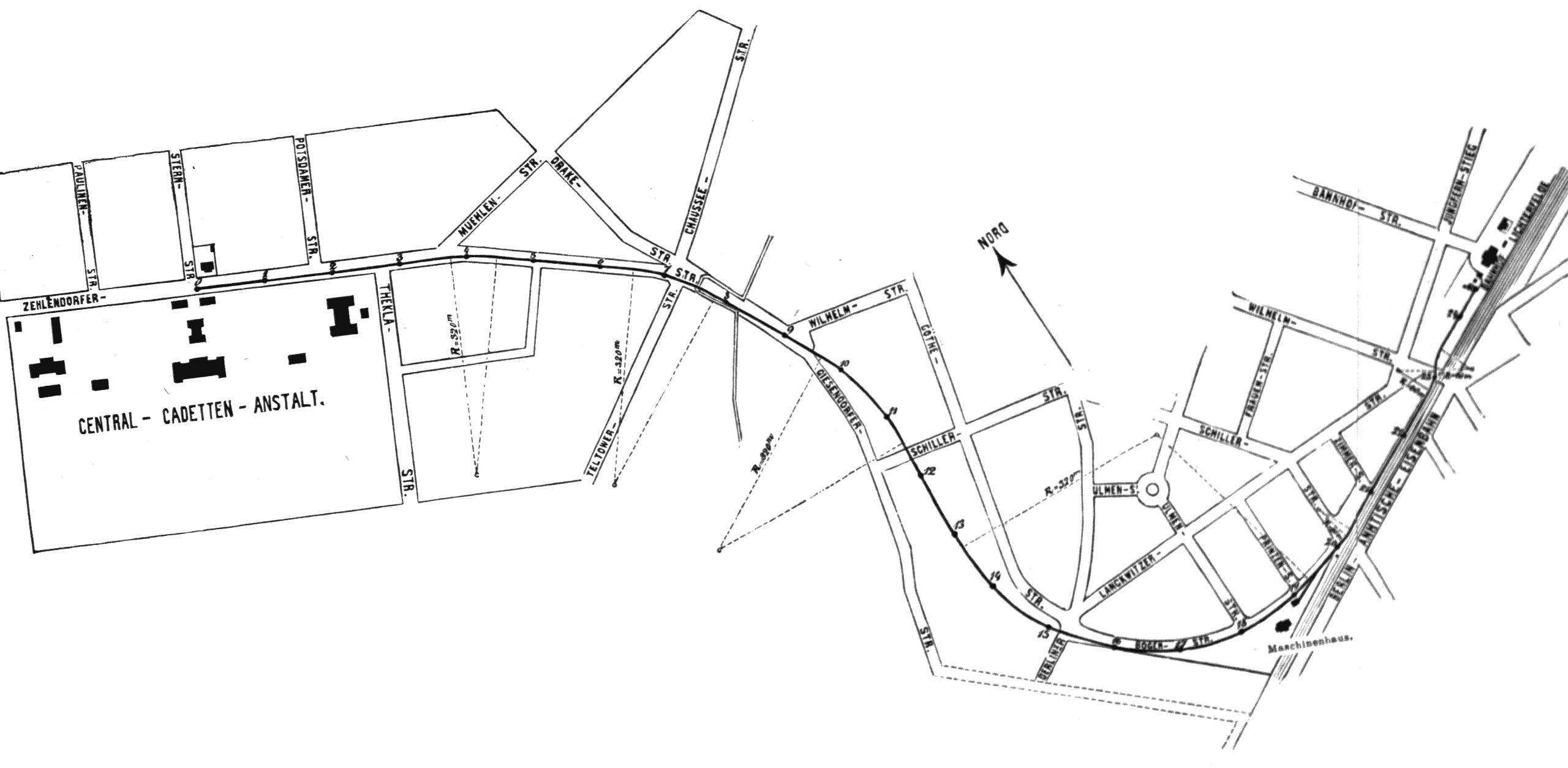Gross-Lichterfelde tramway on:
[Wikipedia]
[Google]
[Amazon]


 The Gross Lichterfelde Tramway was one of the world's first
The Gross Lichterfelde Tramway was one of the world's first
railserve.com, The First in Railroads and Trains
*The Railway News, Volume 56, Oct. 10, 1891, page 578
engagetechnology.com, History of transportationgermaniatours.net Germany
{{coord, 52, 25, 40, N, 13, 19, 32, E, region:DE-BE_type:landmark_source:kolossus-dewiki, display=title Tram transport in Germany History of rail transport in Germany Rail transport in Berlin Steglitz-Zehlendorf Metre gauge railways in Germany 1881 in transport 1881 in Germany


electric tramway
A tram (called a streetcar or trolley in North America) is a rail vehicle that travels on tramway tracks on public urban streets; some include segments on segregated right-of-way. The tramlines or networks operated as public transport are ...
s ( Miller's line was electrified in 1875). It was built by the Siemens & Halske company in Lichterfelde Lichterfelde may refer to:
* Lichterfelde (Berlin), a locality in the borough of Steglitz-Zehlendorf in Berlin, Germany
* Lichterfelde West, an elegant residential area in Berlin
* Lichterfelde, Saxony-Anhalt, a municipality in the Stendhal Distri ...
, a suburb of Berlin
Berlin ( , ) is the capital and largest city of Germany by both area and population. Its 3.7 million inhabitants make it the European Union's most populous city, according to population within city limits. One of Germany's sixteen constitu ...
, and went in service on 16 May 1881.
Overview
Werner von Siemens had presented the first electric passenger train at the Berlin industrial exhibition two years before. In order to develop the concept, he received the official approval to run an electric tramway line on already existing tracks, which had been used for building thePrussian
Prussia, , Old Prussian: ''Prūsa'' or ''Prūsija'' was a German state on the southeast coast of the Baltic Sea. It formed the German Empire under Prussian rule when it united the German states in 1871. It was ''de facto'' dissolved by an e ...
military academy (''Hauptkadettenanstalt'') at Lichterfelde West.
The line started at Berlin-Lichterfelde Ost station on the Anhalt Railway
Saxony-Anhalt (german: Sachsen-Anhalt ; nds, Sassen-Anholt) is a state of Germany, bordering the states of Brandenburg, Saxony, Thuringia and Lower Saxony. It covers an area of
and has a population of 2.18 million inhabitants, making it th ...
line. Each car was originally equipped with a 180-volt DC traction motor
A traction motor is an electric motor used for propulsion of a vehicle, such as locomotives, electric or hydrogen vehicles, elevators or electric multiple unit.
Traction motors are used in electrically powered rail vehicles ( electric multip ...
, the current being supplied via the running rails, in a manner similar to that used by most present-day model railways. Therefore, the tracks were generally separated from roads, and trespassing was prohibited.
At level crossing
A level crossing is an intersection where a railway line crosses a road, path, or (in rare situations) airport runway, at the same level, as opposed to the railway line crossing over or under using an overpass or tunnel. The term a ...
s, the rails were dead or switched on only briefly before the approach of the tramcar. Nevertheless, people and horses frequently received electric shocks. It is also believed that, in order to enjoy the sight of glowing metal, young people caused short circuit
A short circuit (sometimes abbreviated to short or s/c) is an electrical circuit that allows a current to travel along an unintended path with no or very low electrical impedance. This results in an excessive current flowing through the circu ...
s by putting wire mesh on the tracks, which shut down the operation.
In 1891, the tramway was equipped with an overhead wire
An overhead line or overhead wire is an electrical cable that is used to transmit electrical energy to electric locomotives, trolleybuses or trams. It is known variously as:
* Overhead catenary
* Overhead contact system (OCS)
* Overhead equipm ...
, and the line was extended to Berlin-Lichterfelde West station
Berlin-Lichterfelde West (in German Bahnhof Berlin-Lichterfelde West) is a railway station in Lichterfelde West, within the district of Lichterfelde (Steglitz-Zehlendorf) in Berlin, Germany
Germany,, officially the Federal Republic o ...
. There were several further extensions, but operation was discontinued in 1931.
See also
* Trams in Berlin *Elektromote
The Electromote was the world's first vehicle run like a trolleybus, which was first presented to the public on April 29, 1882, by its inventor Dr. Ernst Werner von Siemens in Halensee, a suburb of Berlin, Germany.
In 1847, Siemens told his br ...
References
railserve.com, The First in Railroads and Trains
*The Railway News, Volume 56, Oct. 10, 1891, page 578
engagetechnology.com, History of transportation
{{coord, 52, 25, 40, N, 13, 19, 32, E, region:DE-BE_type:landmark_source:kolossus-dewiki, display=title Tram transport in Germany History of rail transport in Germany Rail transport in Berlin Steglitz-Zehlendorf Metre gauge railways in Germany 1881 in transport 1881 in Germany